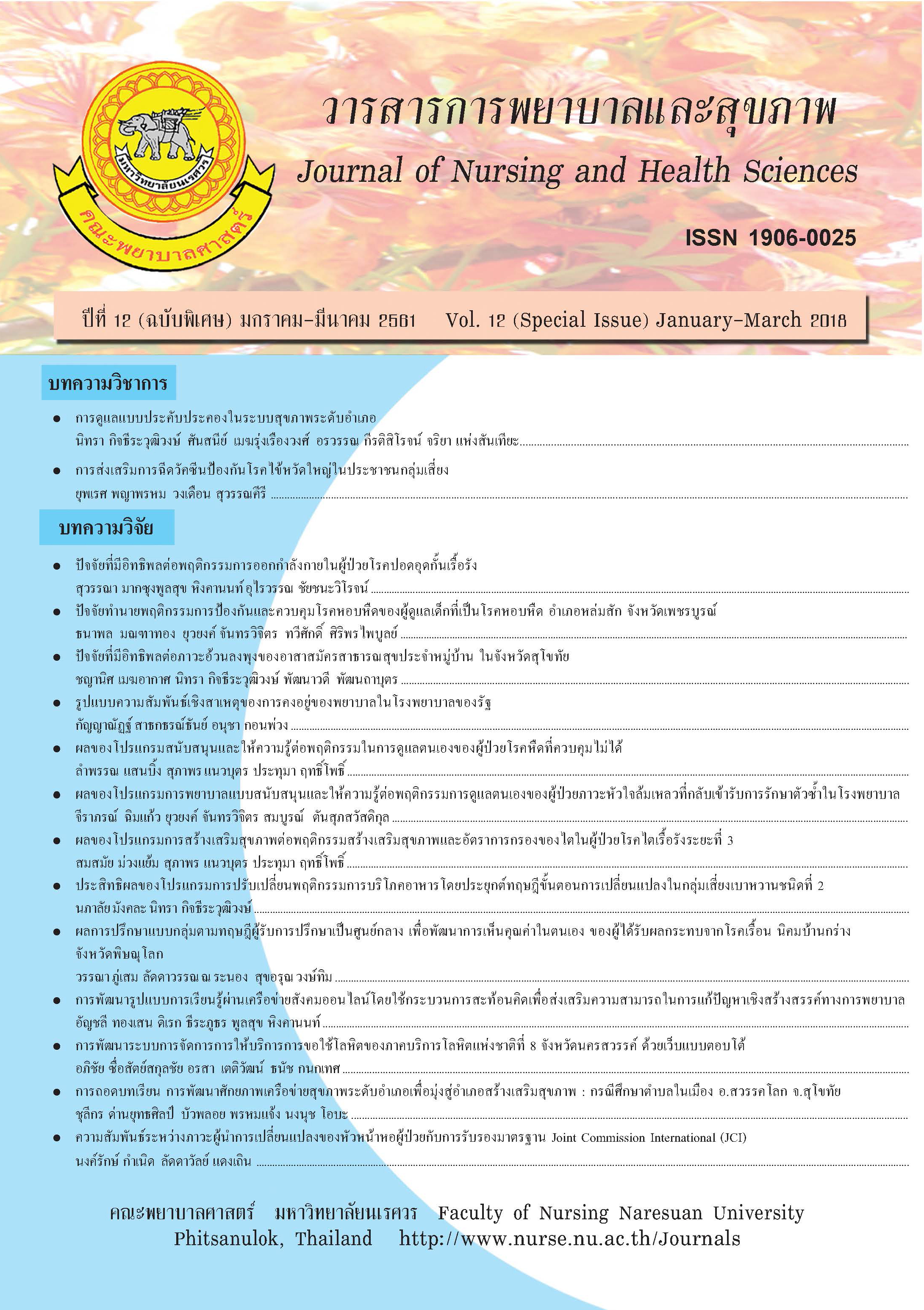Factors Influencing with Abdominal Obesity among Village Health Volunteers in Sukhothai Province
Main Article Content
Abstract
This analytic cross-sectional study was to investigate influence ofdemographic factors, health behavior factors, perceived on abdominal obesity (AO) factors, and enable to prevent AO factors on AO among Village Health Volunteer (VHV) in Sukhothai Province. Samples of VHVs were 360 which were drawn by multi-stagerandom sampling method. Data were collected by questionnaire including; health behavior questionnaire, perceived on abdominal obesity, and enable to prevent AO. Data were analyzed by descriptive statistics and multiple logistic regression analysis. The results revealed that female VHVs were more likely to be AO about 25.91times (ORadj. = 25.91,95% CI: 8.35-80.41), an increasing of body mass index was more likely to AO about 3.41 times (ORadj. = 3.41, 95% CI: 2.55-4.56) and an increasing of self-efficacy to prevent AO was more likely to prevent AO 0.88 times (ORadj. = 0.88, 95% CI: 0.77-0.99). The 4 factors were significantly influenced with AO which accounted for 77.7% of variation in VHVs (p < 0.05).The results suggested that public health personnel should create health behavior program emphasis on establish self-efficacy towards preventing AO, monitor the body mass index. This is an important in targeting appropriate on sex of VHVs in order to decrease risk of AO.
Article Details
References
พฤติกรรมเสี่ยงโรคติดต่อและการบาดเจ็บ
พ.ศ.2553.นนทบุรี สำนักกิจการโรงพิมพ์องค์การ
สงเคราะห์ทหารผ่านศึกในพระบรมราชูปถัมภ์.
กมลวรรณ อ่อนละมัย. (2550). ปัจจัยเสี่ยงที่เกี่ยวข้อง
กับกลุ่มอาการเมแทบอลิซึมในผู้ป่วยเบาหวาน
ชนิดที่ 2 ที่โรงพยาบาลภูมิพลอดุลยเดช
(วิทยานิพนธ์ปริญญามหาบัณฑิต). กรุงเทพฯ:
จุฬาลงกรณ์มหาวิทยาลัย.
ธวัช วิเชียรประภา. (2555).ปัจจัยที่มีผลต่อพฤติกรรม
สุขภาพของอาสาสมัครสาธารณสุขประจำ
หมู่บ้าน จังหวัดจันทบุรี. วารสารสาธารณสุข
มหาวิทยาลัยบูรพา.7(2), 53-68.
ปุญญพัฒน์ ไชยเมล์ และสมเกียรติยศ วรเดช. (2558).
ปัจจัยที่มีความสัมพันธ์ต่อภาวะอ้วนลงพุงใน
นิสิต มหาวิทยาลัยทักษิณ วิทยาเขตพัทลุง.
วารสารสาธารณสุขมหาวิทยาลัยบูรพา, 10(2),
55-65.
พลอยฌญารินทร์ ราวินิจ และอดิศักดิ์ สัตย์ธรรม.
(2559). ปัจจัยที่เกี่ยวข้องกับภาวะอ้วนลงพุงใน
ประชากรตำบลชะแมบ อำเภอวังน้อย จังหวัด
พระนครศรีอยุธยา. สมาคมสถาบันอุดมศึกษา
เอกชนแห่งประเทศไทย ในพระบรมราชูปถัมภ์
สมเด็จพระเทพรัตนราชสุดาฯ สยามบรมราชกุมารี,
5(2), 33-47.
วิชัย เอกพลากร. (2557). รายงานการสำรวจสุขภาพ
ประชาชนไทยโดยการตรวจร่างกาย ครั้งที่ 5
พ.ศ.2557.นนทบุรี: สถาบันวิจัยระบบสาธารณสุข.
สากล สีทากุล. (2555). ปัจจัยที่มีความสัมพันธ์กับ
พฤติกรรมการป้องกันภาวะอ้วนลงพุงของ
บุคลากรสาธารณสุขที่ปฏิบัติงานในโรงพยาบาล
ส่งเสริมสุขภาพตำบล จังหวัดอุบลราชธานี
(วิทยานิพนธ์ปริญญามหาบัณฑิต). อุบลราชธานี:
มหาวิทยาลัยราชภัฎอุบลราชธานี.
สิทธิกร ลินลาวรรณ. (2554). อุบัติการณ์และปัจจัยเสี่ยง
ของภาวะอ้วนลงพุงในบุคลากรโรงพยาบาล
พระจอมเกล้า จังหวัดเพชรบุรี.สืบค้น 9 สิงหาคม
2559, จาก http://www.phrachomklao.go.th/hrd/
reseaech/54/22.pdf
สำนักงานสาธารณสุขจังหวัดสุโขทัย. (2558). รายงาน
ประจำปี 2558.สุโขทัย: สำนักงานสาธารณสุข
จังหวัดสุโขทัย.
สำนักปลัดกระทรวงสาธารณสุข. (2557). ระบบคลัง
ข้อมูลด้านการแพทย์และสุขภาพ.สืบค้นเมื่อ 20
มีนาคม 2558. จาก http://hdcservice.moph.go.
th/hdc/main/index.php.
อนวัช วิเศษบริสุทธิ์. (2556). ภาวะ Metabolic Syndrome
ในบุคลากร โรงพยาบาลมหาราชนครเชียงใหม่.
วารสารสาธารณสุขล้านนา, 9(2), 61-75.
Bloom, B.S. (1971).Handbook on formative and
summative evaluation of student learning. New
York: McGraw-Hill book.
Canoy, D., Boekholdt, S. M., & Wareham, N. (2007).
Body fat distribution and risk of coronary heart
disease inmen and women in the European
prospective investigation into cancer and
nutrition in Norfolk cohort: a population-based
prospective study. Circulation, 116(25), 2933-
2943.
Chen, L., Xu, W. M., & Zhang, D. (2014). Association
of abdominal obesity, insulin resistance, and
oxidative stress in adipose tissue in women with
polycystic ovary syndrome. Fertility and
Sterility, 102(4), 1167-1174.
Daniel, W. W. (1999). Biostatistics: a foundation for
analysis in the health sciences. New York:
John Wiley & Sons.
Derraik, J. G., de Bock, M., Hofman, P. L., & Cutfield,
W. S. (2014). Increasing BMI is associated with
a progressive reduction in physical quality of
life among overweight middle-aged men.
Scientific Reports, 4(3677), doi: 10.1038/
srep03677.
Hill, J. O., Wyatt, H. R., & Peters, J. C. (2012). Energy
Balance and Obesity. Circulation, 126(1), 126-
132.
Krzysztoszek, J., Wierzejska, E., &Zieli๑ska, A.
(2015).Obesity, an analysis of epidemiological
and prognostic research.Archives of Medical
Science, 11(1), 24-33.
Moraes, A., & Falcใo, M. C. (2013). Lifestyle factors
and socioeconomic variables associated with
abdominal obesity in Brazilian adolescents.
Annals of Human Biology, 40, 1-8.
Narksawat, K., Podang, J., Punyarathabundu, P., &
Podhipak, A. (2007). Waist Circumference,
Body Mass Index and Health Risk Factors
among Middle Age Thais. Retrieved 18 June
2015from http://phep.ph.mahidol.ac.th/
Academics/RES_ABS_2007_5.html
Nourian, M., Kelishadi, R. &Najimi, A. (2017). Lifestyle
Interventions and Weight Control of Adolescents
with Abdominal Obesity: A Randomized
Controlled Trial Based on Health Belief Model.
Iran Red Crescent Medical Journal, 19(2), 1-9.
Peige Song, Jinyue Yu, Xinlei Chang, Manli Wang and
Lin An. (2016).Prevalence and Correlates of
Metabolic Syndrome in Chinese Children:
The China Health and Nutrition Survey.
Nutrients, 9(1), 79; doi:10.3390/nu9010079.
Sardinha, L. B., Santos, D. A., Silva, A. M., Coelho-e-
Silva, M. J., Raimundo, A. M., & Moreira, H.
(2012). Prevalence of Overweight, Obesity, and
Abdominal Obesity in a Representative Sample
of Portuguese Adults. PLoS ONE 7(10), e47883.
doi:47810.41371/journal.pone.0047883.
Strecher, V. J., DeVellis, B. M., Becker, M. H., &
Rosenstock, I. M. (1986). The role of selfefficacy
in achieving health behavior change.
Health Education Quartery, 13(1), 73-92.
World Health Organization. (2016). Obesity and
overweight. Retrieved 26 October 2015 from
http://www.who.int/mediacentre/factsheets/
fs311/en/


